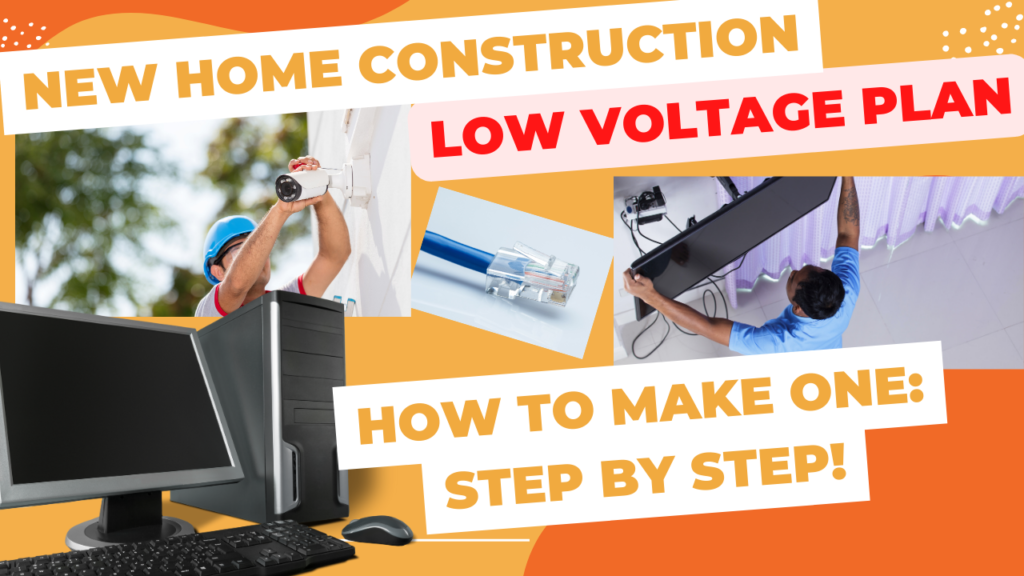The low voltage plan is part of your new construction home’s electrical and wiring plans. When most people think of building a new construction home, they focus on the floor plan. However, the electrical plan brings that floor plan to life. The electrical plan forms the foundation for how you and your family will navigate that floor plan. If you are building a new construction home, you should see and understand your home’s electrical plan. You should also know how to make one in advance of your design center appointment.
The first step in making an electrical plan is to create a wiring diagram, using your home’s floor plan. The wiring plan will show your home’s lighting scheme including things such as the location of your lights, the switches, and outlets. Please see my previous article How to Make a New Construction Home Electrical Plan for more information, and watch our YouTube Video and follow along step by step to make an electrical plan wiring diagram for your home.
After you discuss and plan for your home’s electrical wiring needs, the next step is the Low Voltage plan. Many new construction home building customers discuss Low Voltage needs during their Design Center appointment. Many custom home building clients have a Low Voltage meeting with a Contractor. You should educate yourself about low voltage items before you have a discussion with a contractor.
What is Low Voltage?
The electrical wiring diagram shows your home’s general overall electrical wiring, or “standard voltage” needs. Most wall outlets/sockets are 120 or 24o volts. Most household appliances and lighting runs on standard voltage. While discussing your home’s wiring needs, your builder will take into consideration the placement of the washer/dryer, refrigerator, wall ovens, etc., and your home’s lighting needs when planning out standard voltage. Low Voltage is a term used to describe wiring for electrical that requires less than standard voltage. Most low-voltage wiring carries 50 volts or less.
What are Low Voltage Wiring Plan Items?
Low Voltage plan items in your new home are generally your communications network and security wiring. Because your communication and security wiring is separate from your home’s standard wiring, you may discuss low-voltage needs with a separate contractor that specializes in low-voltage wiring. Low voltage systems are designed using a networked infrastructure that ensures that the current and future security and communications needs of the home are met. Components of your low voltage network are your Cat 5 and Cat 6 wiring and cables for high-speed internet, audio and video needs for media and game rooms, audio and video needs for Smart TVs and whole house audio, planning for fiber optics, coaxial cable for cable television services, indoor and outdoor security systems.
How Do I Make a Low Voltage Plan?
Start by looking at your builder contract, and have a list handy for what your builder includes in their low voltage package. Next, look at your floor plan, preferably, the wiring diagram version of your floor plan that shows your lighting. Consider each element of your home’s low voltage needs one-by-one, for each room. Check out our video if you want to see a simple example of what this looks like.
For example, let’s start with hard-wiring for internet (Cat 5 or Cat 6).
Which rooms will have TVs, computers and gaming consoles? Does anyone in the house work from home? You may want hard-wiring in offices and game rooms so that your connection between the computer, TV or gaming console can be the most direct, fast and reliable connection possible. Based on your floor plan, also consider the best placement for your Wifi routers and signal boosters. Draw the placement of these things onto your floor plan. That way you can keep track of how many you need.
Also, consider whether you will have cable TV and will need coaxial cable.
We only use streaming services at my house, so we didn’t get coaxial cable outlets, but we did ask for Cat 6 for our TVs. However, many households do have cable TV or fiber optics. Will the TV be mounted on the wall? Be sure to consider the location of wall mounted televisions so that you can have an electrical outlet, coaxial cable and cat 6 outlet on the wall behind the TV. No more visible wires! I asked for 2 Cat 6 outlets in my office, (usually 8 inches from the floor) for the computer, and one in the middle of the wall along with an outlet for the Smart TV.
Some new home construction comes with some audio system wiring for surround sound, or other home indoor and outdoor audio.
There may be a certain number of speakers your builder includes, or they may include sound in certain rooms. Be sure to check your contract to see what is included. Decide whether you will work within what is included, or if you want to add onto it. You do not have to buy your audio system from the builder’s contractor, however pre-wiring for current and future audio needs is advantageous. The contractor will help you by recommending the best placement for your surround sound speaker system, and will configure the wiring. Take a look at your home’s floor plan in advance of meeting with the contractor. Think about whether you want to have speakers in every room, certain rooms, or outdoors on the patio. Make your decisions before you meet with a contractor, who may try to upsell you on things you really don’t want or need.
Consider Your Security System.
Many new construction home builders include wiring for indoor and outdoor security systems. Be sure to review your contract so you know what is included. Most people consider security cameras at typical entry points such as garages, front and side doors and patios. Think about where you want security cameras indoors in conspicuous and inconspicuous places that only you know about. Also consider smart home automation and whether you will need to work this into your home security system, even if it is sometime in the future. You are also going to need a smart panel, and network rack to hold the servers for your security system, modem and other components of your low-voltage wiring network.
Congratulations on making a Low Voltage Plan for your New Construction Home! Information is your best friend when meeting with builders and contractors. Look for ideas that others have done, and ask your realtor about other client’s experiences as well. Best Wishes on Your New Home Journey!





